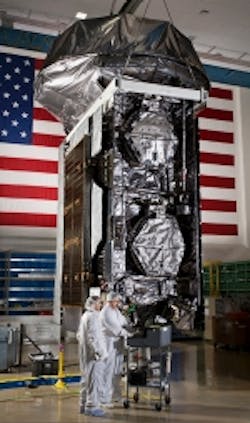Lockheed Martin submits Aegis Combat System Engineering Agent proposal to U.S. Navy
Posted by Skyler Frink
The MUOS constellation is a next-generation narrowband tactical satellite communications system that will augment and replace the legacy Ultra High Frequency Follow-On system, providing significantly improved and assured communications for the mobile warfighter.
The MUOS satellite will now undergo post shipment testing, fueling, payload fairing encapsulation, and mate atop the Atlas V launch vehicle in preparation for launch.
MUOS consists of four geostationary earth orbit (GEO) satellites with an additional on-orbit spare, and a fiber optic terrestrial network connecting four ground stations around the globe. Each satellite will feature two payloads that enable the system to integrate with the existing architecture while upgrading military users to the new wideband code division multiple access (WCDMA) system. Utilizing 3G cell phone and satellite technology, MUOS will provide mobile warfighters point-to-point and netted communications services at enhanced data rates and priority-based access to on-demand voice, video and data transfers.
The second MUOS space vehicle is currently undergoing environmental testing which will validate its performance in a simulated space environment. The third and fourth MUOS satellites are also progressing in the production flow.
Lockheed Martin Space Systems, Sunnyvale, Calif., the MUOS prime contractor and system integrator, is leading a team that includes General Dynamics C4 Systems, Scottsdale, Ariz., and Boeing Defense, Space and Security, El Segundo, Calif. The Navy’s Program Executive Office for Space Systems, Chantilly, Va., and its Navy Communications Satellite Program Office, San Diego, Calif., are responsible for the MUOS program.
Related stories
Lockheed Martin gets $4 billion order to build 30 F-35 advanced combat jets for Air Force, Navy, and Marines
Lockheed Martin delivers surveillance, intelligence and reconnaissance system to U.S. Air Force
Lockheed Martin submits Aegis Combat System Engineering Agent proposal to U.S. Navy

